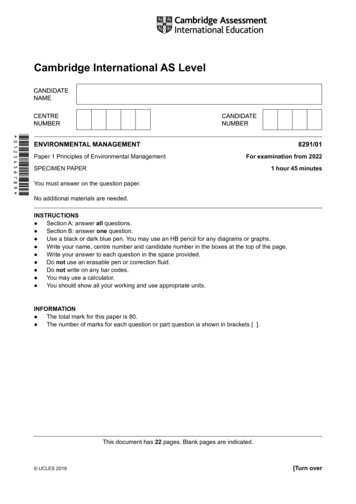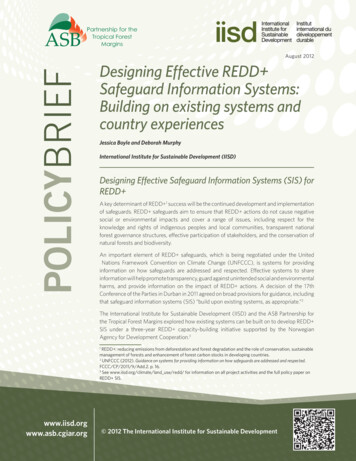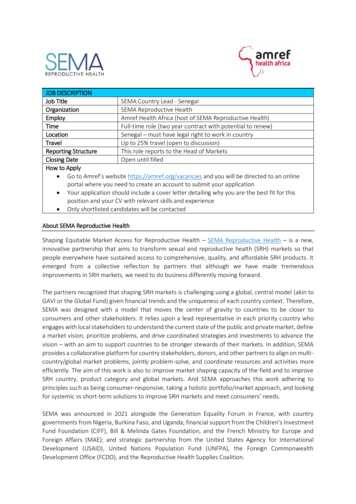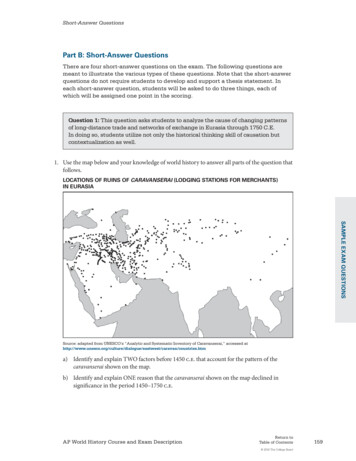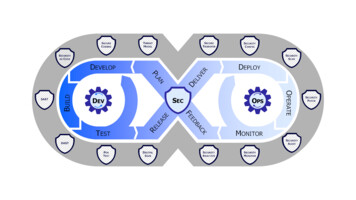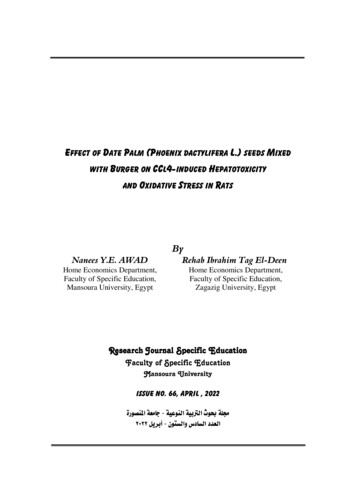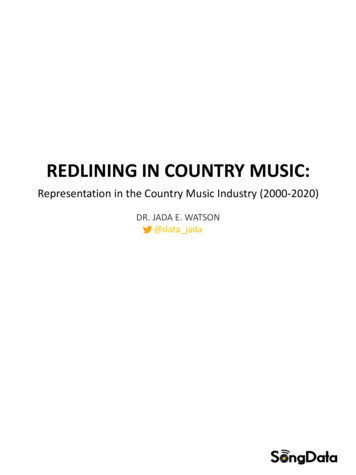
Transcription
Patient Education and Counseling 105 (2022) 965–973Contents lists available at ScienceDirectPatient Education and Counselingjournal homepage: www.elsevier.com/locate/pecPatient-centered innovationDeveloping country-specific questions about end-of-life care for nursinghome residents with advanced dementia using the nominal grouptechnique with family caregivers]]]]]]]]]]Laura Bavelaar a, Maria Nicula b, Sophie Morris c, Sharon Kaasalainen b, Wilco P. Achterberg a,Martin Loucka d, Karolina Vlckova d, Genevieve Thompson e, Nicola Cornally f, Irene Hartigan f,Andrew Harding g, Nancy Preston g, Catherine Walshe g, Emily Cousins h,⁎Karen Harrison Dening h,i, Kay De Vries h, Kevin Brazil c, Jenny T. van der Steen a,j,aDepartment of Public Health and Primary Care, Leiden University Medical Center, Leiden, The NetherlandsSchool of Nursing, McMaster University, Ontario, CanadaSchool of Nursing and Midwifery, Queen’s University Belfast, Belfast, Northern Ireland, UKdCenter for Palliative Care, Prague, Czech RepubliceCollege of Nursing, University of Manitoba, Manitoba, CanadafCatherine McAuley School of Nursing and Midwifery, University College Cork, Cork, IrelandgDivision of Health Research, Lancaster University, Lancaster, UKhSchool of Nursing and Midwifery, De Montfort University, Leicester, UKiDementia UK , London, UKjDepartment of Primary and Community Care, Radboud uNiversity Medical Center, Nijmegen, The Netherlandsbca r t i cl e i nfoa bstr ac tArticle history:Received 15 January 2021Received in revised form 16 July 2021Accepted 20 July 2021Available online xxxxObjective: We aimed to develop question prompt lists (QPLs) for family caregivers of nursing home re sidents with advanced dementia in the context of a study involving Canada, the Czech Republic, Italy, theNetherlands, the United Kingdom and Ireland, and to explore cross-national differences. QPLs can en courage family caregivers to ask questions about their relative’s end-of-life care.Methods: We used nominal group methods to create country-specific QPLs. Family caregivers read an in formation booklet about end-of-life care for people with dementia, and generated questions to askhealthcare professionals. They also selected questions from a shortlist. We analyzed and compared the QPLsusing content analysis.Results: Four to 20 family caregivers per country were involved. QPLs ranged from 15 to 24 questions. Aquarter (24%) of the questions appeared in more than one country’s QPL. One question was included in allQPLs: “Can you tell me more about palliative care in dementia?”.Conclusion: Family caregivers have many questions about dementia palliative care, but the local contextmay influence which questions specifically. Local end-user input is thus important to customize QPLs.Practice implications: Prompts for family caregivers should attend to the unique information preferencesamong different countries. Further research is needed to evaluate the QPLs’ use. 2021 The Author(s). Published by Elsevier B.V.CC BY 4.0Keywords:DementiaFamily caregiverPatient engagementShared decision makingEnd-of-life careNursing home1. IntroductionHealthcare professionals are increasingly adopting patient-cen tered care that is sensitive to the patient’s preferences and needs [1].⁎Correspondence to: Department of Public Health and Primary Care, LeidenUniversity Medical Center, Hippocratespad 21, Postbox 9600, 2300 RC, Leiden, TheNetherlands.E-mail address: jtvandersteen@lumc.nl (J.T. van der 38-3991/ 2021 The Author(s). Published by Elsevier B.V.CC BY 4.0This requires patients to be engaged in the decision-making process,to be informed about the positive and negative features of eachoption and to be aware of their own values and preferences that canguide the decision [2].Patient engagement in the context of advanced dementia can bechallenging. There are numerous quality and ethical issues, such asthe cognitive ability of the person with dementia to understand andcontribute to the conversation [3,4]. Consequently, family caregivers-for example partners or adult children- are expected to represent
L. Bavelaar, M. Nicula, S. Morris et al.Patient Education and Counseling 105 (2022) 965–973their relatives with dementia when they are no longer able to ex press own wishes [5]. However, family caregivers may lack a goodunderstanding of dementia and end-of-life care [6,7]. To address thisissue, Arcand and colleagues developed an informational bookletabout comfort care for nursing home residents with advanced de mentia: the Comfort Care Booklet [8]. The aim of the booklet is toprepare family caregivers for the end of life and reassure them aboutthe patient’s comfort. The Comfort Care Booklet has been translatedand adapted for use in various countries [9–13]. The Comfort CareBooklets were developed by healthcare professionals with inputfrom patients and family caregivers. Involving end-users can lead tomore user-friendly information [14].Although family caregivers welcome information about dementiaand end-of-life care, information provision itself is not enough: thereis a need for follow-up conversations with healthcare professionals[15]. As families will often not explicitly share their information andsupport needs with healthcare providers, they need assistance inexpressing these needs so that they can be met [15]. An aid to in crease patient or family caregiver engagement is a question promptlist (QPL) [16]. A QPL is a list of typical questions, that can encourageindividuals to ask questions about their relative’s care. Thus,healthcare professionals can provide personally relevant informa tion. Hyatt, Lipson-Smith and colleagues [17] found that patientswith cancer experienced a QPL to be supportive to their care, butalso recommended that QPLs should be culturally-tailored and pa tient-driven. For example, the development of a QPL for patientswith cancer in the US and Australia led to two different versions assome aspects were deemed less acceptable or useful in the UScompared with Australia [18].Currently, available QPLs about illness and treatment to supportdecision making (e.g. [19–22]) are mostly tailored for patients withcancer. A QPL to support family caregivers of nursing home residentswith advanced dementia is not internationally available. Therefore,the objective of this study was to develop a QPL for family caregiversof nursing home residents with advanced dementia. The purpose ofthe new QPLs was to complement the Comfort Care Booklet [8–13]by encouraging question asking and aid conversations about care.In this study, we consult current and bereaved family caregiversin five countries to ensure family-driven and culturally-tailored QPLsfor dementia. We assessed differences between countries in the re sulting QPLs to examine importance of the local context.The team aimed to reduce the number of questions to 50 and toinclude at least one question per topic discussed in the Comfort CareBooklets: dementia, end-of-life decision making, symptom relief,and end of life. Questions were deemed appropriate for inclusion ifthey were relevant to the nursing home setting and within the scopeof the Comfort Care Booklets. ‘Nursing home’ is used to refer to acollective institutional setting in which care is provided to olderadults 24 h a day, including nurses and medical staff. Question se lection took place in three consensus rounds and was informed bythe inclusion criteria in Box 1. In the Netherlands, three researchers(LB, WPA, JTvdS) independently selected questions and discussed toreach consensus. In parallel, two researchers from the UK followedthe same procedure (SM, KB). Next, the results of these two in dependent consensus rounds were discussed between the re searchers from the two countries in a third consensus round. Apreliminary selection of 39 questions was thus completed in pre paration for Phase two.2.2. Phase twoPhase two (November 2019 – July 2020) involved the targetedconsultation of end-users of the QPLs. End-users in each countryindependently compiled the final selection of questions for the QPLto address local needs. End-users were defined as current or be reaved family caregivers of people with dementia. The eligibilityrequirements were: over 18 years of age; sufficient capacity of thelocal language to read the Comfort Care Booklet and participate inthe discussion; and able to agree to terms and conditions of parti cipation. The consultation protocol was reviewed by local ethicscommittees in Canada (Hamilton Integrated Research Ethics Board:2019–5837-GRA) and the Netherlands (Medical Ethical CommitteeLeiden-Den Haag-Delft: N19.114) and written informed consent wasobtained from all participants. In the Czech Republic, Ireland and theUK, the consultation was considered ‘Public and PatientInvolvement’ and therefore the process was exempt from review byethics committees and formal consent procedures. In Italy, theconsultation could not be performed due to COVID-19.Convenience recruitment strategies included local invitationsand snowballing. In Canada, family caregivers involved at the nur sing home that participates in the larger project were invited by thesite’s social service coordinator. The Czech team recruited partici pants using the Facebook page of the Center for Palliative Care andby using the snow-ball method, that is: participants invited othersfrom their social networks to participate. In collaboration withAlzheimer Nederland, the Dutch team invited family caregivers whoare part of the Alzheimer panel from a west and middle region overemail. The team in Ireland posted flyers in public spaces and onFacebook, and invited potential participants via personal and pro fessional networks. In the UK, researchers recruited family care givers through their local patient and public involvementconnections around Leicester and through the network of a familycaregiver that was involved in previous projects in Lancaster.The consultation process was structured in the four steps (seebelow) of a nominal group technique [27,28]. Although normallyconducted in a group setting, the first two steps were adapted toallow family caregivers to complete them individually at home. Thiswas done to ensure that participants were sufficiently prepared forthe group discussion. The group discussion was virtually conductedin some cases using email, phone calls or videoconferencing (seeSupplementary information Text S1). The steps were conducted asfollows:2. MethodsThis study is part of an international EU Joint Programme –Neurodegenerative Disease Research (JPND) project to support familycaregivers of nursing home residents with advanced dementia in deci sion making, called ‘mySupport study’, involving Canada, the CzechRepublic, Italy, the Netherlands, the UK and Ireland. The QPLs were de veloped with the targeted consultation of family caregivers. The aim ofthe development process was to agree on the final QPLs with 20–25questions. This process took 13 months and was divided into threephases as described below and depicted in Fig. 1. An evaluation of theQPLs in practice was outside the scope of the current study and will beaddressed during the larger mySupport study [23].2.1. Phase onePhase one (July 2019 – September 2019) involved an elderly carephysician, two researchers specialized in palliative care, a researchertrained in psychology and a researcher educated in neuroscience.This team selected a set of questions from three available QPLs (twoabout dementia care and one about palliative care). The QPLs ori ginated in three different countries (Australia [24], Canada [25], theNetherlands [26]), providing a transnational overview of questions(248 questions in total, 206 without duplicates).2.2.1. Silent-generation step (individually at home)Upon reading the Comfort Care Booklet, family caregivers wrotedown any questions that came to mind and that they would wish to966
L. Bavelaar, M. Nicula, S. Morris et al.Patient Education and Counseling 105 (2022) 965–973Fig. 1. Outline of the three-phase process for developing country specific question prompt lists. QPL question prompt list; AU Australia, CA Canada, CZ the Czech Republic,IT Italy, NL the Netherlands, ROI Republic of Ireland, UK the United Kingdom. *In Italy, Phase 2 could not be performed due to the large impact of COVID-19.discuss with a healthcare professional. They also wrote down theirreasoning for posing these questions.minimize bias in the facilitation of the discussion. Family caregiversread all the questions as a group and discussed each item’s simila rities, differences, and reasons for its inclusion in the final list.Observers took notes on reasons for inclusion and exclusion ofquestions.2.2.2. Round-robin step (individually at home)Afterwards, the family caregivers selected approximately 15questions of the 39 pre-selected questions that they felt may arisewhen a family member reviews the Comfort Care Booklet. Finally,the family caregivers could add any outstanding questions that werenot yet addressed; once again, they wrote down their rationale forposing these questions.2.2.4. Voting stepAfter the group discussion, participants voted on which items toinclude in the QPL by raising hands or highlighting them on acollective list. The 20–25 questions that received the most voteswere included in the final list. The research team mapped thequestions from the final list onto the relevant sections of theComfort Care Booklet to ensure that there was at least one questionper topic.2.2.3. Discussion/item clarification stepA moderator presented all individually generated and selectedquestions to the family caregivers at the group discussion. Themoderator was not involved in the preliminary question selection to967
L. Bavelaar, M. Nicula, S. Morris et al.Patient Education and Counseling 105 (2022) 965–973Box 1Criteria for question pre-selection by research team (Phase 1).1.2.3.4.The question is not already answered in the Comfort Care Booklet.The question probes for relevant information or more personal or in-depth information.The question is of cultural, care practice or legislative relevance to at least one of the participating countries.The question is not purely medical or medical-technical, and can thus be addressed by a long-term care staff member from the relevant occupation (for example, by anurse or a social worker).5. The question cannot be answered or on the contrary, is already covered by the Comfort Care Booklet, but is still pressing to family caregivers (according to literature andresearchers’ experience in practice) and bringing it to the table would be beneficial.Highlights We developed country-specific question prompt lists about dementia palliative careIn five countries, family caregivers were consulted to finalize a list of questionsAll caregivers selected: “Can you tell me more about palliative care in dementia?”Included topics differed across countries, namely artificial nutrition and fluids2.3. Phase threediscussion resulted in a final list of questions in each of the coun tries. Canada decided upon 15, the Czech Republic had 20, Irelandhad 22, and the Netherlands and the UK each had 24 (Tables 1and S2).Phase three (June 2020 – August 2020) involved two researchers(MN, Canadian and LB, Dutch), who compared the final QPLs fromeach country to highlight similarities and differences across contextsusing conventional content analysis [29]. First, LB and MN familiar ized themselves with all of the questions. They then inductivelyderived a set of codes from the questions and labeled each questionwith a code. Next, codes were sorted into themes when referring to asimilar overarching topic. Finally, code names were adjusted afterdefining the themes, and themes were refined after adjusting thecodes. Reasons for including questions that were available in fieldnotes or participants’ answer sheets were collected and also un derwent a content analysis to explore any cross-national differencesin the rationale for including questions in the QPLs.To ensure validity and rigor [30], all steps of the analyses wereindependently performed by two individual coders (LB, MN). Codes,themes and interpretations were discussed at each step to reachconsensus.3.3. Phase threeQuestions were scanned for overlap and similarity, leading to alist of 76 distinct questions from the total of 105 selected questions.Almost a quarter (24%, 18/76 questions) were selected by more thanone country. Question 2 from the pre-selected list of 39 questionswas selected by all groups:“Can you tell me more about palliative care in dementia?”For 55/105 questions (52%) the reason for inclusion was clearlydescribed in the field notes or participants’ answer sheets. The CzechRepublic (70%), Canada (67%) and the Netherlands (63%) had moreinformation about the rationale available than the UK (37%) andIreland (32%). The reasons that were provided for selecting questionswere aggregated into the following six themes, in order of fre quency: just obtaining information, preparation for end of life, re assurance, preparation for shared decision making, informing staffabout the resident’s needs and informing staff about the familycaregiver’s needs (Table 3). The reason provided most often percountry was just obtaining information in the UK, preparation forend of life in Ireland, and just obtaining information and preparationfor shared decision making in the Czech Republic. In the Nether lands, informing staff about the resident’s needs was directly fol lowed by reassurance and just obtaining information. Canada hadmentioned reassurance, just obtaining information and preparationfor end of life at equal frequency.The inductive content analysis of the QPLs resulted in 18 codes(Table 4). The most common codes were communication with staff,care protocols, palliative care information, and roles and responsi bilities. The codes were aggregated into seven broader themes. Theseinclude Request for (services or) information about (1) Symptomsand Disease, (2) Treatment, (3) Death, (4) Care staff, (5) Care setting,(6) Request for the increase or use of patient values and wishes, or(7) Request for information about shared decision-making. Overall,the three most common themes across all countries were Requestsfor Services or Information pertaining to Care Setting (5), Treatment(2), and Care Staff (4).3. Results3.1. Phase oneOut of the 206 questions, the UK team selected 33 and the Dutchteam 49. Ten questions were selected by both teams, totaling 72questions. The two teams agreed on the in- and exclusion of 75%(186/248) of the questions. Cross-national differences were apparentduring the consensus discussion. For example, questions about lifetermination and prognosis seemed inappropriate to the UK teambecause they were difficult to answer adequately, and end of life andeuthanasia were not considered topics that people tend to discuss.They were pressing to the Dutch team because people will often askabout these issues and there was a concern of creating taboo whenexcluding such questions. Table 1 shows the 39 questions that werepre-selected by the research teams upon reaching consensus.3.2. Phase twoTable 2 shows an overview of the nominal group for eachcountry. Forty-three people participated, ranging from 4 to 20 percountry. The ages ranged from 25 to 87 years, and the majority (72%)was female. The participants were current or bereaved family care givers (n 41) or living with dementia (n 2). Six participants hadprofessional experience with dementia. The group discussions took40–140 min. The characteristics of the moderators and observers areincluded in the supplementary information (Table S1). The group3.3.1. Symptoms and diseaseQuestions about symptoms and disease focused on the prognosisof the person with dementia in terms of upcoming death or the signsand symptoms related to dementia stages, and disease-related968
L. Bavelaar, M. Nicula, S. Morris et al.Patient Education and Counseling 105 (2022) 965–973Table 1List of pre-selected questions (Phase 1) and selection per country (Phase 2930313233343536373839QuestionSelected byCan you tell me more about palliative care in dementia?What changes can I expect, still, such as worsening of symptoms or behavior?When there is no solution for very unpleasant symptoms such as pain or shortness of breath, will the doctor have other options (such aslower the level of consciousness, put to sleep by means of ‘palliative sedation’), so my/our loved one is less aware of them, or can wediscuss the level of awareness we prefer?What do you want to know about my loved one, so you can provide appropriate and quality care, now and later on?What role might I or other family members be expected to play in decision making such as decisions about to transfer to hospital orchange medication?Is it possible to record wishes regarding end-of-life care now, and if so: how, and how often are these being reviewed?Can you tell me what “comfort care” means?Can you tell me how much time is left?Can you warn me, the relative, when death is near?Can my loved one be admitted into a hospice?I would like to talk about how my family member would want to be cared for. When can I discuss this and with whom?Can you arrange for me to talk with someone from my culture, someone who may understand me better?Can someone help me to communicate with other members of my family about what is happening?How do we ensure positive experiences?What are advantages and disadvantages of resuscitation in this case?What spiritual or religious care is available to us?Is it feasible for my loved one to die at home?What should or can I, the relative, do at the moment of death and afterwards?What is the best way for me and my family member to communicate our needs, concerns, and questions to the staff?How can I make arrangements to meet with the doctor?Is it possible for me to see someone else if I don’t get along with the nurse or doctor? How do I go about this?What are the worst days going to be like, and what are the best days going to be like?Can you alleviate symptoms and provide some comfort?How do we ensure incontinence does not affect dignity?My loved one has dementia but also other medical conditions. How might this affect their care at the end of life?Do people die from dementia?What might the final days and hours of my family member’s life look like?Who can help me sit up with my dying loved one/relative? Are there volunteers we can call in?What if my loved one/relative dies when I am not there?What possibilities are there not to prolong life in a natural way?Can we ask for life-terminating treatment, if things really go worse?What can help me or my loved one accept that my loved one is no longer able to do things, or know things (cope with/prepare for losses)?How confidential is the information? For example: are other family members allowed to know about medical problems or behaviorproblems?When could hospitalization be necessary and when is it not a good idea?Can you help me to work out questions I may wish to ask my other doctors/specialists?Are medications necessary [for the problem] or can we try something else first?How do I recognize that I am overburdened?How might your care of my family member change in his/her final days?What aftercare is available to me, like speaking to the doctor again?CA†, CZ, NL, ROI, UKCA†, CZ, ROI, UK*CA*, CZ, NL, UK*CA*, NL, UKCA, CZ*, ROI*CA*, NL, UK*CA†, CZ, NL*CA* CZ, UKCA†, CZ*, ROI*CA, CZ*, UKNL, UKNL, UKROI, UKCZ, ROIROI*, UKNL, ROI*CZ*, UKNL, ROI†CA*UK*UKCZNLNLUKROI†CA*NLNLNL*The original question was rephrased by the participants †The original questions were combined into one question.complications such as problems with nutrition or hydration.Questions about how the disease or various methods of treatmentwould affect the resident’s nutrition and hydration were only in cluded in the Czech QPL. The reasons for including questions fromthis theme mainly related to preparation for end of life and justobtaining information.3.3.2. TreatmentQuestions in this theme consisted of general questions abouttreatment options or information about palliative care, but alsospecific questions about pain management options, and treatmentoptions for pneumonia or problems with nutrition or hydration. Allfive countries submitted questions that were related to this theme.Table 2Nominal group information (Phase 2).CACZ**NLROI**Month, year ofphase 2Number ofparticipants in phase 2Duration of groupdiscussion (minutes)Setting of group discussionNumber ofquestions in final QPLNov 2019 –Jan 2020Feb 2020 –April 2020Nov 2019 –Dec 2019March 2020 –4140Nursing home155*120Online (home)2020(i): 135(ii): 120(i): 40(i): Alzheimer Nederland Offices 24(ii): LUMC conference room(i): Health care facility22conferenceroom(ii): Family caregiver’s gardenVideo call, phone, email (home) 246*July 2020UK**March 2020 –June 2020(ii): 60860 (videocall)*Number of participants providing individual input; 2 Czech participants and 1 Irish participant could not join the group discussion. **Group discussions had to be performed inalternative formats to accommodate for COVID-19 restrictions. (i) group discussion 1, (ii) group discussion 2.969
L. Bavelaar, M. Nicula, S. Morris et al.Patient Education and Counseling 105 (2022) 965–973Table 3Family caregivers’ reasons for selecting questions.ReasonExplanationJust obtaining informationThe answers to these questions are important for people to know and could address misunderstandings; the answerdoes not necessarily influence preparations or plansThe answers to these questions would allow for family caregiver to obtain knowledge that will inform preparationfor end of lifeThe answers to these questions would allow for family caregivers to feel better about (future) scenarios by soothingconcerns and providing confirmationThe answers to these questions could set up the family caregiver to prepare for or make decisions in aninformed mannerAsking these questions would allow the family caregiver to inform or prepare staff about the resident’sneeds and wishesAsking these questions would allow the family caregiver to inform or prepare staff about their own needs and wishes forsupport and involvementPreparation for end of lifeReassurancePreparation for shared decision makingInforming staff about the resident’s needsInforming staff about the familycaregiver’s needspolicies and protocol that the home followed, such as securitymeasures and visiting policies. The reasons for including questionswithin this theme related to reassurance and preparation for endof life.Most Dutch questions on treatment were specific to learning moreabout palliative care and comfort care. The Czech Republic focusedmore on treatment of specific conditions with pneumonia and pro blems with nutrition or hydration. The rationale for includingquestions from this theme focused on just obtaining information.3.3.5. Care staffThese questions related to concerns about communication withstaff, including whom to contact (and how), and concerns about staffcompetence in providing palliative care. While all groups expressedthe need for clear information on communication with staff, the UKgroup had the highest proportion of questions related to this. Thequestions surrounding staff competence were only asked by the UKand Czech Republic groups. Questions from this theme were in cluded for various reasons; reassurance and informing staff aboutthe resident’s needs were mentioned most often.3.3.3. Controlling death circumstancesThe questions in this theme were about controlling the circum stances of death such as active life termination and choosing theplace of death. Family members from all the countries, except forIreland, asked questions that were specific to changes (in setting ortreatment) or preferences for circumstances at the end-of-life. Therewas limited information about the reasons for including questionsfrom this theme, which varied.3.3.4. Care settingCare setting-related questions concerned possibilities in terms ofspecialist services that could be accessed (spiritual, support, medicalspecialists). It also included questions about how day-to-day care isbeing managed, about general policies in the care facility and aboutthe logistical procedures that coordinate care and responsibilities.All countries—except the Czech Republic—asked a large proportionof questions about the services and coordination offered by thenursing home. Canada focused on specialist services, while Irelandwas the only group that submitted questions regarding the specific3.3.6. Patient values and wishesThe questions in this theme were about specific preferencestatements such as living wills. This theme also contained questionsabout values guiding decisions such as the patient’s dignity. Thequestions pertaining to dignity were most often asked in the CzechRepublic, Ireland and the Netherlands. The questions were asking forreassurance that the patient’s dignity would not be compromised asa result of the treatment options or otherwise. The reasons forTable 4Themes and codes derived from the question prompt lists, with example questions (Phase 3).Themes1. Request for (services or) information aboutsymptoms and disease2. Request for (services or) information abouttreatment3. Requests for (services or) information aboutdeath4. Requests for (services or) information aboutcare staffCodesExample questions (country)Prognosis: deathDementia trajectoryHow close is my loved one to the end of their life? (ROI)What changes can I expect, still, such as worsening of symptoms or behavior? (CZ,ROI, UK)What is the association between pneumonia and introducing a PEG? (CZ)How can swallowing disorder be alleviated while food intake is conserved? (CZ)What pain management is available and which one do you advise and why? (NL)What are some alte
c School of Nursing and Midwifery, Queen's University Belfast, Northern Ireland, UK d Center . Prague, Czech Republic e College of Nursing, University Manitoba, Canada f Catherine McAuley School of Nursing and Midwifery , University College Cork Ireland g Division of Health Research, Lancaster University , Lancaster UK h School of .
